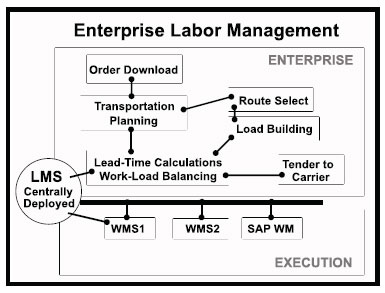|
This
article was originally publshed
in The Supply Chain Digest Letter,
our hardcopy newsletter focused
on a single topic each month
(June, 2007 issue on Labor Management
Systems). To subscribe to the
SCDigest Letter (free for qualified
professionals), click
here. To view of Labor Management
System Resource page, click
here:
Labor Management System (LMS)
Information and Resources.
For a
long time, labor management
solutions (LMS) for distribution
have been shrouded in a kind
of secrecy. These software tool
sets were originally developed
by Industrial Engineers on personal
computers and have focused tightly
and in depth on warehouse operations.
|
Dixon Says:
|
 Labor
management then must be
an enterprise application
and not hidden in the warehouse. Labor
management then must be
an enterprise application
and not hidden in the warehouse.

What
do you say? Send
us your comments here
|
Rightfully
so. That focus has resulted
in the low-risk, high-ROI solution
for improving performance and
throughput. Today, the market
is maturing and LMS is being
accepted by more than just the
Grocery industry as a supply
chain application.
Labor
is a basic distribution cost
and constraint (labor, inventory,
transportation and assets) and
is probably the most variable
of the four at least in North
America and Europe. A company’s
labor investment needs broader
visibility and a larger domain.
As work flows down and across
the distribution network labor
is committed and becomes significant
constraint to customer service.
The commitment is warehouse
labor for order fulfillment
and value added services but
also yard labor, driver capacity
and dwell time commitments.

Source:
Catalyst International
As
work is committed and performed,
the accuracy of the estimate
and subsequently the capacity
of the network as a whole will
drive out opportunities. Labor
management then must be an enterprise
application and not hidden in
the warehouse. The information
labor management presents needs
to start with forecast and progressively
improve in accuracy to plan
for work that is being committed,
goal time and finally the standard
for the individual task. This
is the approach taken by Catalyst
International with Labor Management.
Agree
or disgree with our expert's
perspective? What would you
add? Let us know your thoughts
for publication in the SCDigest
newsletter Feedback section,
and on the web site. Upon request,
comments will be posted with
the respondents name or company
withheld. |